Louann’s – Part 3
by Paul Heckmann, Executive Director, Memories Inc.
Be sure to check out Part 1 and Part 2 if you haven’t already!
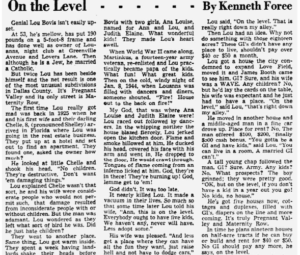
Lou Bovis, Ana Louise, Judith Elaine, Pregnant Valley and Maternity Row, April 1947
Pat Martinkus
Son of Anton Andrew “Marty” Martinkus and nephew of Ann and Lou Bovis.
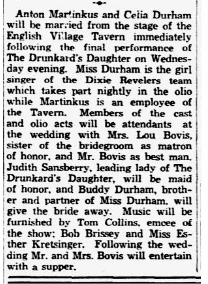
Anton and Celia getting married at The English Tavern on the State Fair Property, 1939
Paul: Tell me about your Dad and how he came to work at Louann’s
Pat: Dad came down for the State Fair Exposition in 1936 to work with Uncle Lou and Aunt Ann. That’s where dad met my mom when they were working there.
Mom and Dad lived in the house that was behind the original part of Louann’s. Dad got called back up in 1942 and was gone when the accident happened. Mom was there alone with my two sisters when the place caught on fire. Uncle Lou tried to get to them, but he couldn’t. Mom was lucky to get out alive.
I was the first of the boys born when dad got back from the service. Then he had five more, there was six of us total.
I kinda grew up in Louann’s in the late 50’s and early 60’s. I can remember going up to Louann’s when I was about four years old. Uncle Lou was still alive, he had a big office kinda off to the side. I remember him picking me up like big guys do with little kids. He really loved kids. That was my only real memory of seeing him. He died around 1950.
Dad left Louann’s sometime in the late 50s, maybe 7-8 years after Uncle Lou died. We moved to Richardson for a while, then dad decided to open up a Mexican food restaurant in Carthage, Texas. You think Carthage was small? We actually lived in a little town called Gary about 10 miles outside of Carthage. As for the Mexican restaurant, where the heck he got that, I have no idea. It didn’t work out to well and within a year were back in Dallas.
Dad died when I was 15 and Ann kinda took me under her wing, she tried to make sure I went straight. She did a good job for the most part. She tried to put me through college but too much partying, girls and beer kinda ended that. Then Uncle Sam stepped in. More on that later.
Ann was a remarkable lady. I probably owe her my life. She took me in, took me to restaurants and really taught me so much about life that I might not have ever learned if she hadn’t been there. And she did all this while running that by herself for twenty years. She was there from morning to midnight just about every day. And she looked out for other kids too. Louanns was the only place youngsters could get into those days as the drinking age was 21. Ann would let the kids in just go to keep them off the street but don’t let her catch you with a drink in your hand.
Paul: What did you do there?
Pat: I really loved working there, all those bands and people. It was really exciting! We would go in every morning, stack the chairs on the tables, sweep the floors, stock the bars. There were two, one in the front and one in the back.
And Ann was really the guiding force behind Louann’s. She was inventive. She added the ‘To Go’ place on the Lovers Lane side. We cooked hamburgers and pizzas, she added a Barbecue pit and 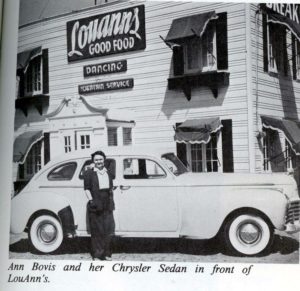 we cooked brisket. Ann’s sister, My Aunt Stella and her husband came down from Chicago where they had a pizzeria. Uncle Pete was a master pizza maker. He did everything from making the dough from scratch, ground the cheese, sliced the pepperoni. So he taught us how to do everything.
we cooked brisket. Ann’s sister, My Aunt Stella and her husband came down from Chicago where they had a pizzeria. Uncle Pete was a master pizza maker. He did everything from making the dough from scratch, ground the cheese, sliced the pepperoni. So he taught us how to do everything.
This fella Lee would come over from across the street and eat there several times a week. He was working for Mr. Hardy at his golf range. He kept us in stitches every-time he came by. A few years later I’m reading Stars and Stripes and low and behold, there he is ‘Lee Trevino wins the US Open!’
At night I would usually work as a ticket taker. Ann sold tickets at the front to get in and I would stand there and take them. When I turned 18, I started bar-tending. Sometimes in the cold weather, we would rent the place out for private parties, so I might be working in the coat check room.
As for the bands, by the time I got there the big band era was pretty much over. We started having the popular groups like The Drifters, and folks like Bo Diddly – I really liked him, Ike and Tina Turner while they were still together and then there was Jimmy Reed – he was a mess, his wife would sit down there in the front row and mouth the words to the songs so he could remember what he was supposed to sing.
I went in the Navy in 1966 and stayed in through 1970 so Louann’s was pretty much over by the time I got out.
After all that I joined the Garland Police Department and retired from there in 1993. I was able to buy my military time into the retirement system, which got me out of there a little quicker. Since then I’ve been in residential real estate with my wife. She had been doing it for a long time. I got my license while I was still in the Police Department so I hit the ground running.
Paul: Thanks so much for your time Pat. What a great snapshot of Louann’s
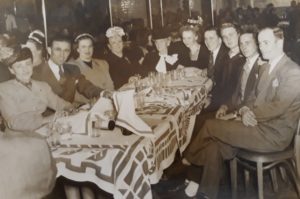
Folks having a great time at Louann’s.
“Infinite Tuesday”, by Micheal Nesmith
Permission granted and excerpted from INFINITE TUESDAY: AN AUTOBIOGRAPHICAL RIFF Copyright © 2017 by Michael Nesmith. Published by Crown Archetype, an imprint of Penguin Random House.
There was a club in the late 1950s in Dallas called Louann’s, a hangout for dancing and drinking and carousing. It was mostly for the throwaway evenings of drunken college kids, but the musical acts that played there would become the stuff of legend, some of the most famous players in rock and roll history. Chuck Berry, Little Richard, Fats Domino, Ike and Tina Turner all played there, and these were the secondary acts.
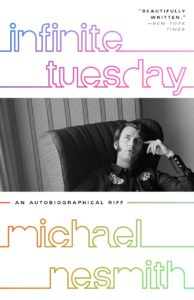
Permission granted an excerpted from INFINITE TUESDAY: AN AUTOBIOGRAPHICAL RIFF Copyright © 2017 by Michael Nesmith. Published by Crown Archetype, an imprint of Penguin Random House.
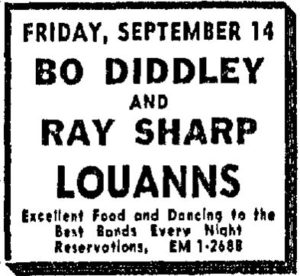
Bo Diddley and Ray Sharp at Louann’s
The club’s headliners were the big country acts of the time, like Ray Price. Strangely, the biggest act in Louann’s history was Lawrence Welk’s polka orchestra, which drew over six thousand people—not that the club could seat them.
When the acts that appealed to me came through Louann’s, I would go if I could. One night I went to see Bo Diddley. I wanted to watch him and Peggy and Jerome doing live what I had only heard them doing on record—to see if it was real. When they took the stage I could see that this was a band of the strangest and highest order.
Bo created an astounding presence, with his low-slung homemade guitar, his white sport coat and bow tie, his band all in red plaid jackets with bow ties—except for Peggy. She was in a skintight one-piece gold lamé suit and stiletto heels. She was attached to a low-slung electric guitar similar to Bo’s. They were playing through Fender Reverb amplifiers. Before they played a note, their presence made the whole room crackle with electricity. When they played, something started up like a powerful engine, different than with any other players I had heard.
The cantilever that Bo and Peggy created in their rhythms made space for itself, just like the art of Marcel Duchamp and Richard Hamilton, Hendrix and Lennon. The maracas mixed in the legacy touch of Latin claves and a drop of Southern hambone, so when Peggy and Bo added the thunder from their guitars, the result was a pulse that made everyone move, that made me want to sing, that sat me straight up and held me there. When the thunderclaps started pausing in tight syncopation with the drums, the rhythm roared like a wind-driven rainstorm on water.
And when Bo sang “I look like a farmer, but I’m a lover!” I knew exactly what he was singing about, what he was saying. Bo and Peggy and Jerome were the first iteration of the Jimi Hendrix Experience in my life, the first time I kissed the sky. When Bo played live that night, I heard music for the first time that matched what I heard in my head. Up till then, I heard lots of music that came close but wasn’t ever really complete. The twelve songs on that first Bo Diddley record from 1958 became my foundation in rock and roll. When I played my solo section on the first Monkees tour, it was Jerome Green holding eight maracas at Louann’s that I would emulate in homage.
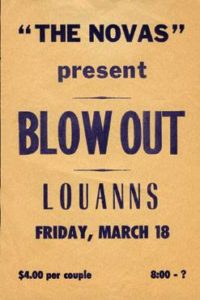
Tony Zoppi to the Dallas Morning News’ Bob St. John, Sept 1982
Tony covered Dallas nightlife in Dallas during the 1950s and 60s writing ‘Dallas After Dark’. After 17 years in Vegas (Riviera) Tony moved back to Dallas around the first of the year…taking over Public Relations at the Fairmont
“I can’t believe the changes in Dallas” he was saying the other afternoon. “My old beats are now parking lots and garages downtown. When I was here before, Greenville Ave was in the boondocks. The only club there was Louann’s, and now the clubs are wall-to-wall.“
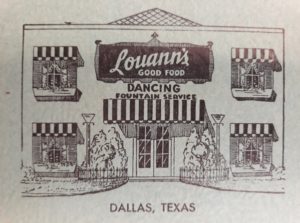
Album cover for Louann’s photos
Dale Smith
Singer with The Buccaneers, The Allusions, The Cast of Thousands, Surely Goodness and Mercy, The Audience, Care Package and Fat Band
Paul: Tell me about coming to Dallas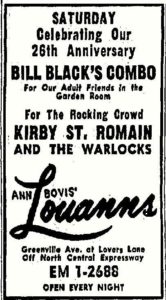
Dale: The Allusions came to Dallas around May of 1965, and we played our first Dallas gig at Louann’s. Our friends from Oklahoma, The Mutineers had come down to Dallas where had been signed to a new label and were now known as The Five Americans. They had just recorded “I See The Light” with Dale Hawkins producing.
Paul: Tell me about the acoustics.
Dale: We never really worried about the acoustics. We could never hear ourselves over the crowd anyway. There was simply so many people there, they were lucky to hear us!
Our gig at Louann’s was on the big stage. We split sets with The Five Americans. On the little stage was The Chessmen with a 15 year old Jimmy Vaughan in the band. They were splitting sets with a band called The Warlocks with Lady Wild. The Warlocks had bassist who happened to play cello at Woodrow Wilson HS named Dusty Hill, with his brother Rocky playing lead. They also had a drummer named Little Richard Harris.
We were splitting sets with those guys playing the same time as The Chessmen. So we would go watch The Warlocks. My drummer Garland Scarberry dragged me back to the patio behind the stage. There were these four big windows, about 6′ tall and 2′ wide. You could see the whole back of the band from behind the stage, especially the drummer.
Garland spent the rest of the night between sets watching Little Richard Harris. He was fascinated by the way he twirled his drumsticks and studied him all night. All the way back to Ardmore, Garland practiced twirling his sticks. By the time our next gig rolled around, he had it down He turned into a great showman, as well as a great drummer.
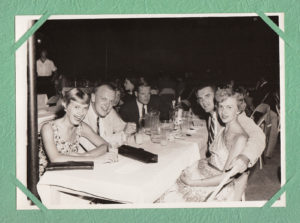
Larry Lavine
Owner of Studio Club, Louann’s, Kitty Hawk and Founder of Chili’s
Paul: Tell me about growing up in Dallas.
Larry: I’m from Dallas, went to Highland Park HS. I was always pretty independent but my dad died when I was young so I guess that made me even more so. I went to college at SMU and later UT Austin
Paul: Before we get into Louann’s, can you tell me a little about the Studio Club? 
Larry: Sure, I had just got out of college. Studio Club was originally an adult nightclub that someone had built and spent a lot of money on it. So we decided to put in a club for teenagers that was only open on weekend during the school year. We opened in about 1965 and closed it down around 1971. We had local bands for the most part and sold SoHos and Cokes and Dr Peppers.
However from time to time we would have a big name like Chuck Berry or the Yardbirds. ZZ Tops played there too.
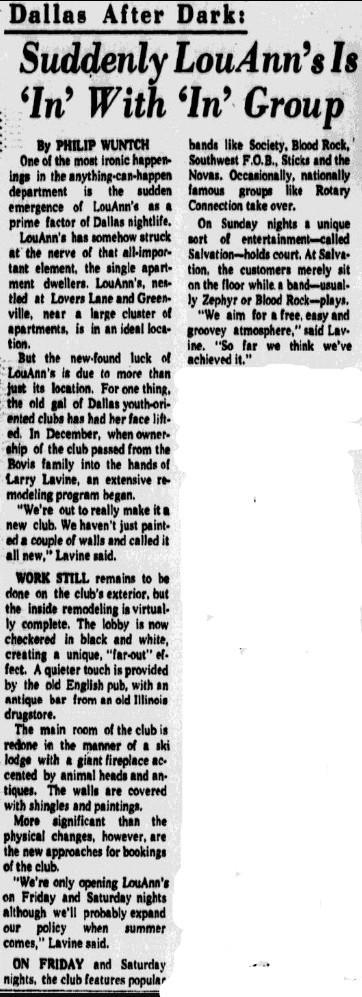
December 1970 Dallas Morning News
Paul: And tell me about purchasing Louann’s.
Larry: We did so well with the Studio Club that I decided to branch out. I approached Ann about purchasing Louann’s and we worked out a deal, that was back in 1969.
Paul: At this point the property was about 29 years old. That’s a lot of years for any nightclub.
Larry: True. We put in a lot of work and money into Louann’s to bring it up to par. It had been around for a long time and wasn’t in the best shape for what we wanted to do. We ran it on the same concept as the Studio Club, open on the weekends and in the summer.
Tony Todora was the landlord then. Louann’s was leasing from him. He wanted to tear it down in 1970 as the property was becoming so valuable which of course didn’t happen. But I guess in a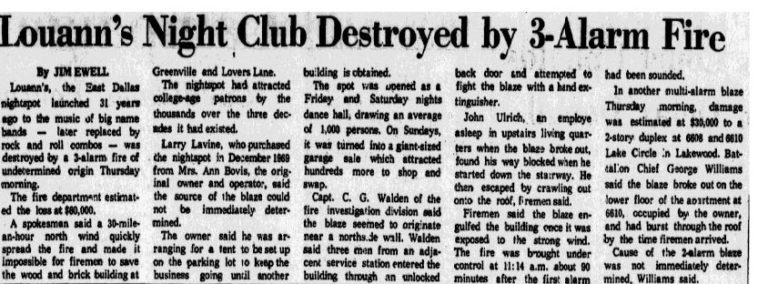 way he got his wish in 1971 when the place burned down.
way he got his wish in 1971 when the place burned down.
Paul: Oh that was tragic. A lot of memories. How did you find out about the fire?
Larry: Not sure that I remember. I know I was not too far away and drove over while it was still burning. We had just paid off the purchase price shortly before that.
Paul: Did you recoup some of the money you lost from insurance?
Larry: No, back then that didn’t exist for that situation. It was a total loss for all of us.
We rebuilt Louann’s in back on the Matilda side but it was never the same. Every club has a life and that one was over.
We ended up closing Louann’s and a short time later opened the same building as my first restaurant, ‘Kitty Hawk’. I did that with a partner, Malloy Buckner. At the same time we were developing the concept for Chili’s. My partner was more interested in Kitty Hawk so I sold him my interest and devoted all my time to Chili’s.
Paul: And of course on to ‘overnight fame’ at Chili’s
Larry: We had a great team there. We were all young and crazy and got along so well.
Paul: I think that’s a whole story in itself. For another time.
One last question. I read that you married Carol Shelby’s daughter, is that correct?
Larry: Yes it is. He was a great guy.
Paul: And that is definitely something for another day. Thank you so much for your time
You can add comments at the bottom of this page – and be sure to add your email in the Newsletter Registration link.
Come see us on Facebook at: https://www.facebook.com/groups/MemoriesofDallas/
We also have a new sister page for Football and Cheer-leading in Texas at https://www.facebook.com/groups/texasfootball
If you would like to donate a few dollars to keep articles like this coming, please Click Here! We are a fully approved 501c3 non-profit. Your donations are deductible, see your CPA.
All copyrighted materials included within Memories Incorporated dba Memories of Dallas are in accordance with Title 17 U.S.C. Section 107 related to Copyright and “Fair Use” for Non-Profit educational institutions, which permits Memories Incorporated to utilize copyrighted materials to further scholarship, education, and inform the public. Memories Incorporated makes every effort to conform to the principles of fair use and to comply with copyright law.
You can also share this story on your Facebook page or Twitter, click on the links below.
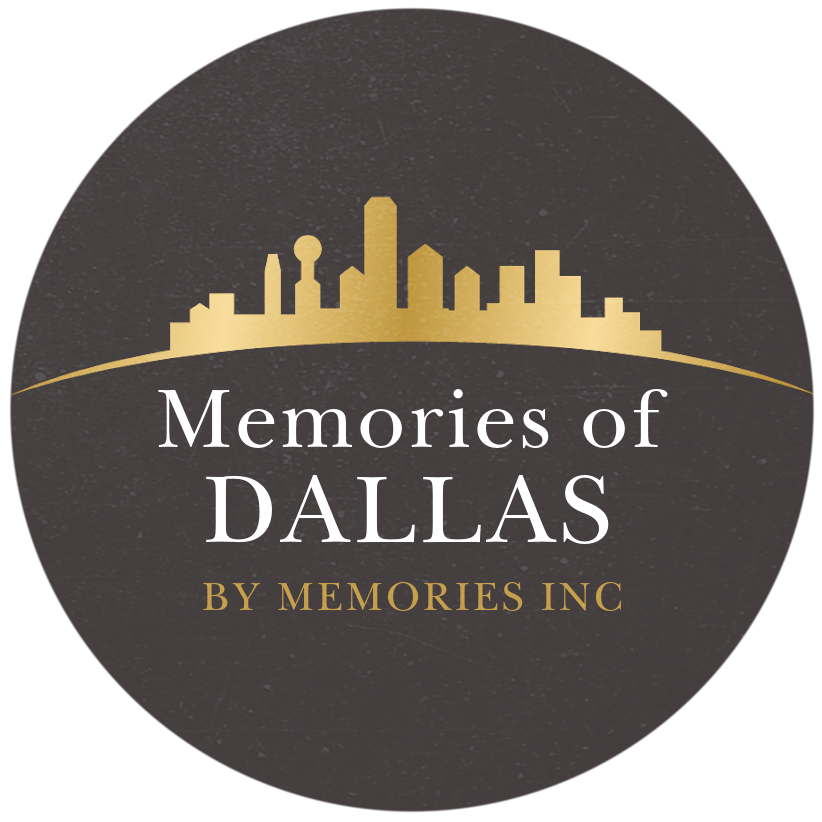


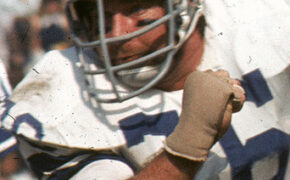

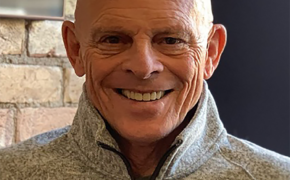
Al E Hockaday Jr.
My Senior Prom after prom party in spring of 1972 was held at the Studio Club
pheckmann
Larry Lavine’s foray into the club scene